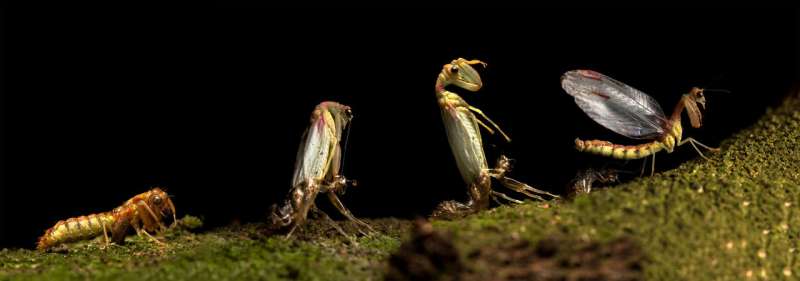Chance record of an annual mass emergence of enigmatic mantis-flies

Being neither mantids nor flies, the peculiar mantis-flies are in fact predatory lacewings which use their mantis-like forelegs to catch prey. While most mantis-flies are known to feed on spider eggs in their immature stages, the larval lifestyle of one subfamily—the Drepanicinae—has remained a mystery.
That is until James Dorey, an accomplished insect photographer and student of entomology at the University of Queensland, encountered a mass emergence of rarely-seen adults in his father's macadamia orchard in eastern Australia, as reported in the open access Biodiversity Data Journal.
Right before James' eyes and camera, the pupae were coming out from under the ground to grasp hold of tree trunks and undergo the final moult to emerge as adults.
Not only did he take some beautiful photos of the insects, but he also managed to capture a stunning time-lapse video of the pupae moulting into the adult stage.
The young researcher then contacted his university lecturer, David Merritt, to find out more about the phenomenon he had encountered. Together, they approached experts on mantis-flies, including Trevor Lambkin who was able to identify the insects as belonging to the mystery group, whose immature stages have so long remained unknown.
James managed to obtain some eggs from a fertile female and observed them hatch to produce tiny larvae that were immediately photographed and described in detail for the first time in a scientific journal.
"It is likely that the immature stage of these mantis-flies' life cycle takes place underground in moist or forested habitats, perhaps explaining why it has never been recorded before," explain the authors.
Yet to answer is the question what the immature mantis-flies feed on: is it spider eggs just like their relatives or some other underground-dwelling insect or arachnid?
"Perhaps some digging around in the macadamia orchard at the right time of year will reveal the answer," say the researchers.
James is currently at Flinders University in Adelaide, carrying out a genetic analysis of the diversification of Fiji's native bees.
More information: James Dorey et al, First observations on the life cycle and mass eclosion events in a mantis fly (Family Mantispidae) in the subfamily Drepanicinae, Biodiversity Data Journal (2017). DOI: 10.3897/BDJ.5.e21206
Provided by Pensoft Publishers



















